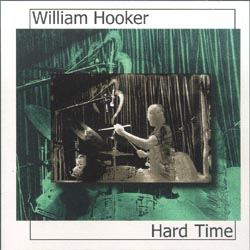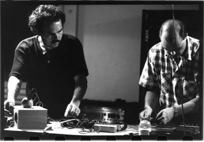(These are excerpts from my book "A History of Jazz Music")
Noise jazz

The white San Francisco-based Rova Saxophone Quartet
was the alternative and experimental alter-ego of the more famous
World Saxophone Quartet.
Formed in 1977 by Jon Raskin, Larry Ochs, Andrew Voigt and Bruce Ackley,
on respectively baritone, tenor, alto and soprano saxophone
it straddled the border between free jazz and classical music of the 20th century.
Raskin had already founded several multimedia projects and worked with composer John Adams.
Their first concert became also their first album,
Cinema Rovate' (august 1978), highlighted by
Raskin's chaotic and cacophonous 21-minute Ride Upon the Belly of the Waters
After The Bay (december 1978) with Italian percussionist Andrea Centazzo,
the noise strategy of the group was perfected on
The Removal of Secrecy (february 1979), particularly
Ochs' 19-minute That's How Strong.
There was method in their madness, but it was not easily detected within the
dense structures of their scores.
After Daredevils (february 1979) with guitarist Henry Kaiser,
and the transitional This This This This (august 1979),
with Raskin's eleven-minute Flamingo Horizons,
Invisible Frames (october 1981) boasted another peak of their
expressionist art, Voigt's 22-minute Narrow Are the Vessels.
Ochs' 19-minute Paint Another Take of the Shootpop, off As Was (april 1981), was dedicated to both classical composer Olivier Messiaen and soul vocalist Otis Redding. Rova's style was becoming more accessible while still being abstract, absurd and atonal.
After the live double-LP Saxophone Diplomacy (june 1983), with a
24-minute Detente or Detroit, and the Steve Lacy tribute of
Favorite Street (november 1983),
the Rova Saxophone Quartet sculpted the titanic jams of
Crowd (june 1985), such as
the 19-minute The Crowd,
Ochs' 29-minute Knife In the Times and
Raskin's 16-minute Terrains.
TM, ®, Copyright © 2006 Piero Scaruffi. All rights reserved.

Black drummer William Hooker, who moved to New York in 1974, remained fundamentally faithful to the aesthetic of free-jazz (despite a passion for exoteric/spiritual themes), starting with
the double-LP
Is Eternal Life (may 1975),
a set of collaborations with other improvisers (including tenor saxophonists David Murray and David Ware, notably the lengthy trio Soy with Murray and a bassist)
and with Brighter Lights (1982) in a trio with flutist Alan Braufman and pianist Mark Hennen.
Drumming and poetry coexisted on the albums of his relatively traditional period:
Lifeline (august 1988) for a quartet with piano and alto plus tenor saxophonist Charles Compo and trombonist Masahiko Kono;
Colour Circle (february 1988) for a trio with saxophonist Booker Williams and trumpeter Roy Campbell;
Firmament Fury (april 1989), in a quintet with alto saxophonist Claude Lawrence, tenor saxophonist Charles Compo, trombonist Masahiko Kono and Borbetomagus' guitarist Donald Miller.
Subconscious (april 1991) contained the 20-minute drum solo Crisis.
Rediscovered by Sonic Youth's guitarist Thruston Moore for the rock audience,
Hooker returned to a more abstract and free-form kind of creative improvisation
in the main works of his prolific middle age:
Darkness (november 1992) and The Spirits Return (april 1994) on the live Radiation, by Hooker's band featuring Miller, electronic musician Brian Doherty, Compo, Kono;
a duet with Moore (Sirius) and an electroacoustic duet with guitarist Elliott Sharp (The Hat) on Shamballa (1993);
the 40-minute The Coming One and the 24-minute Big Mountain off Tibet (june 1994), with piano (Mark Hennen), saxophone (Compo) and guitar (Donald Miller);
the 31-minute duet with Sonic Youth's wildly dissonant guitarist Lee Ranaldo Matches on Envisioning (april 1994).
the 17-minute live duet with violinist Billy Bang Sweating Brain (june 1994) on Joy;
the 51-minute Stamina that added Zeena Parkins' harp to the Ranaldo-Hooker duo on the live Gift of Tongues (1995);
the eight-movement solo-percussion sonata Heat Of Light (august 1995).
The albums with Ranaldo were heavily influenced by his screeching sounds, just like the albums with Donald Miller were heavily influenced by his turbulent wall of noise.
Armageddon (february 1995) marked a change in
direction, both because the improvisations turned towards a more sophisticated
kind of soundpainting and because the stylistic palette expanded dramatically,
ranging from a dadaistic duet with turntablist Gregor "DJ Olive" Asch
to the 16-minute free jam State Secrets for drums and two guitars.
However, Hard Time (december 1995) was one of his most violent albums ever, featuring an electro-acoustic quintet with Donald Miller, electronic keyboardist Doug Walker, guitarist Jesse Henry and saxophonist Richard Keene.
Nonetheless, the experiment with the turntable was continued on Mindfulness (august 1996), that featured DJ Olive as well as reed player Glenn Spearman,
on Bouquet (april 1999), a cacophonous live jam with turntablist Christian Marclay and Sonic Youth's wildly atonal guitarist Lee Ranaldo,
and on the live Complexity #2 (september 2000), containing the 41-minute Twelve Windows for ocean waves, drumming, electronic keyboards (Doug Walker) and turntable (DJ Olive).
TM, ®, Copyright © 2006 Piero Scaruffi All rights reserved.
Noise percussionist Charles Noyes conceived some of
the most cerebral improvised music on Free Mammals (june 1979),
for guitar and percussion, and
The World And The Raw People (august 1982), solos and duos with saxophonist
John Zorn, trumpeter Lesli Dalaba and guitarist Henry Kaiser.

New York's white trio Borbetomagus
produced hurricanes of free-jazz music for two saxophones (Jim Sauter and Don Dietrich), guitar (Donald Miller) and electronic distortion.
Their delirious improvised bacchanals constituted a sort of "baroque" style
of the ugly and the noisy.
The devastating early "concordats" of Borbetomagus (april 1980) and Work On What Has Been Spoiled (april 1981),
the cacophonous symphony Barbet Wire Maggot (may 1982), perhaps their most extreme statement,
the abstract and grotesque soundpainting of
Industrial Strength (october 1981) and
Borbeto Jam (october 1981), i.e. the last "concordats" for a septet including trumpeter Toshinoro Kondo, bassist Peter Kowald, cellist Tristan Honsinger and clarinetist Milo Fine,
that seemed to exhaust the expressive power of the "concordats",
and Fish That Sparkling Bubble (march 1988), a ferocious collaboration with
noise-meisters Voice Crack (Norbert Moeslang and Andy Guhl),
had little in common with the traditional quest for "sound" in jazz, a quest
for an atmospheric, romantic and, ultimately, pleasant sound.
TM, ®, Copyright © 2006 Piero Scaruffi. All rights reserved.

Voice Crack, the duo of Swiss musicians Andy Guhl (percussion and bass) and Norbert Moeslang (reeds), made music with broken objects found in garbage cans and adopted the extreme improvisation of free-jazz. Albums such as Knack On (october 1982) and the live Concerto for Cracked Everyday-Electronics and Chamber Orchestra (may 1994) were Dadaist acts of musical rebellion.
TM, ®, Copyright © 2006 Piero Scaruffi All rights reserved.

Swiss trio 16-17 (saxophonist Alex Buess, drummer Knut Remond and guitarist Markus Kneubuhler) played pummeling dissonant improvised industrial-jazz music that drew inspiration from both Borbetomagus and Peter Brotzmann on ferocious albums such as 16-17 (1986) and When All Else Fails (1989).
TM, ®, Copyright © 2006 Piero Scaruffi All rights reserved.
Latvian collective ZGA specialized in playing found, self-made and traditional instruments in a percussive way, starting with ZGA (recorded between 1984 and 1988).
The 1980s also witnessed a new generation of creative vocalists.
White wordless vocalist Jay Clayton created one of the most cerebral languages of free-jazz singing. She came into her own only much later than her counterpart Jeanne Lee, debuting with b>All Out (october 1980).
San Francisco-based vocalist Bobby McFerrin cut The Voice (march 1984), the first solo vocal album in the history of jazz music. His vocal style was among the most versatile since the days of Jeanne Lee and Jay Clayton, although the material had often the effect of turning his improvisations into novelties rather than avantgarde. In fact, he later crossed over into pop and even classical music, returning to creative improvisation only with Circlesongs (may 1996).
Next chapter | Back to the Index
|




